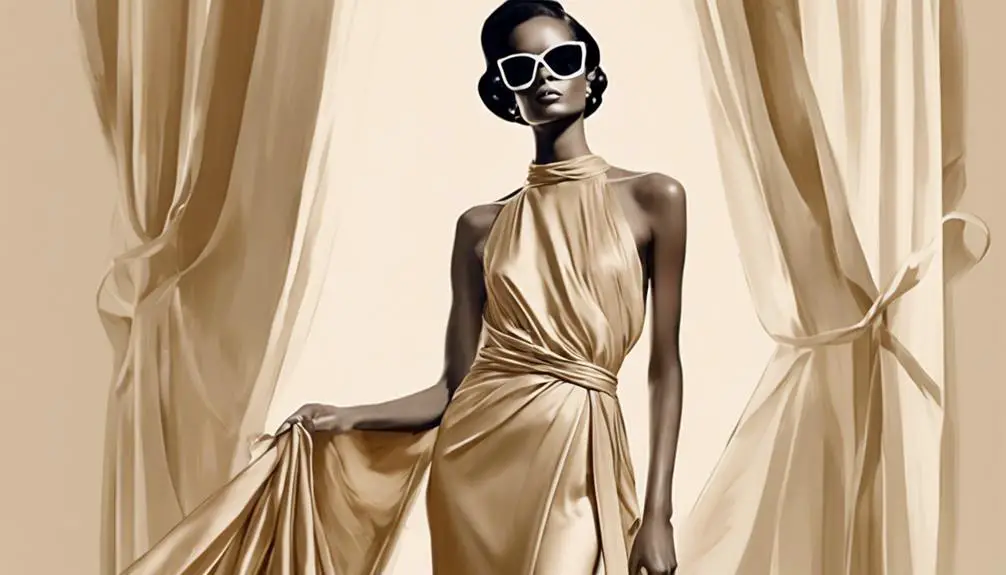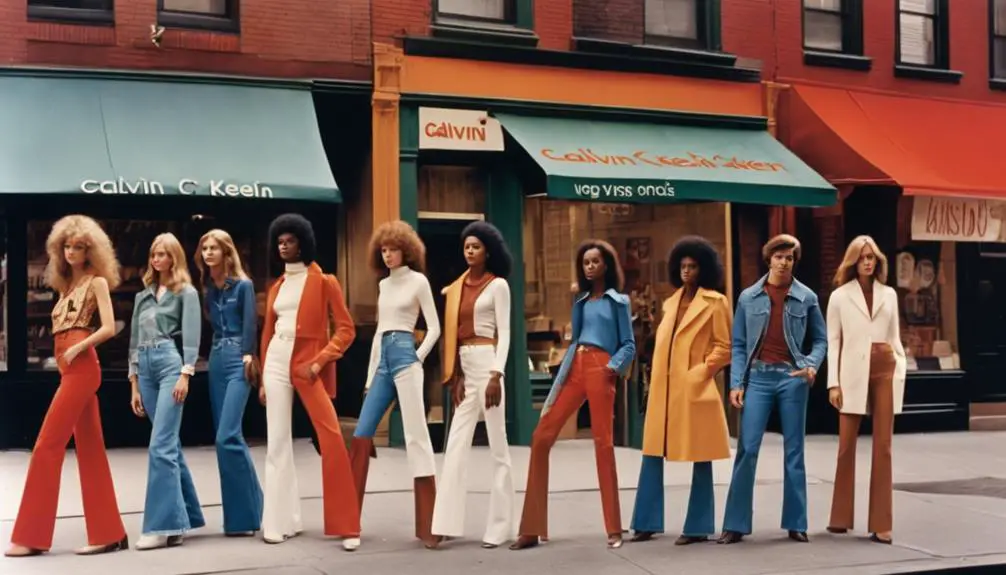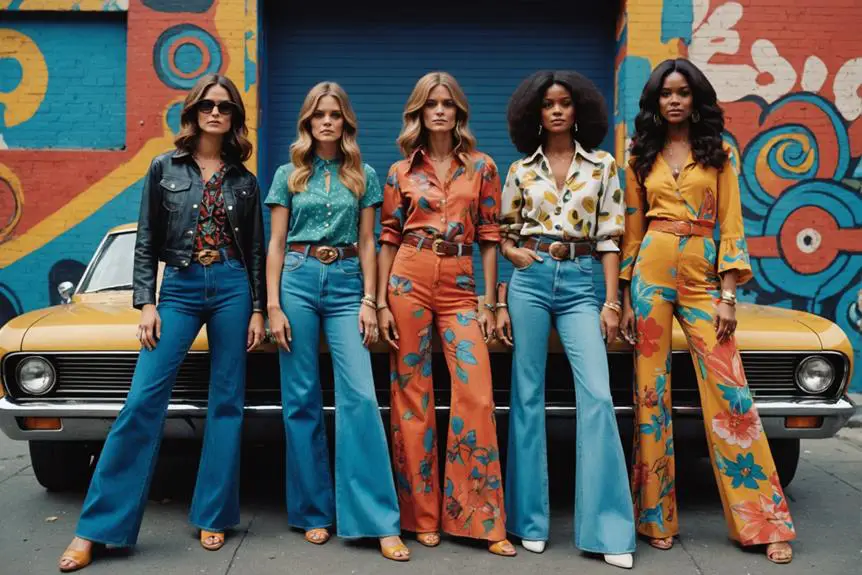What if you could step into a world where fashion served as a canvas for self-expression? In the early 1970s, brands like Halston, Yves Saint Laurent, and Biba didn't just create clothing; they crafted identities. Each label brought something unique to the table, from Halston's minimalist designs to Biba's vibrant prints. As you explore these influential names, you'll uncover how their innovations not only shaped personal style but also reflected the cultural shifts of the era. What was it about this period that made these brands so iconic?
Halston's Minimalist Chic

In the early 1970s, Halston emerged as a defining force in fashion, showcasing minimalist chic that captivated a generation. His luxury designs emphasized clean lines and simplicity, creating an aesthetic that was both sophisticated and accessible.
You'd notice how Halston popularized the back-revealing halterneck dress, which became a staple of disco fashion, embodying the glamorous nightlife of the era. His creations weren't just pieces of clothing; they were statements that spoke to the freedom and vibrancy of the time.
Halston's innovative use of Ultrasuede, a synthetic fabric that mimicked the feel of suede, revolutionized the way fabrics were perceived in high fashion. This material allowed for a blend of comfort and elegance, allowing women to dance the night away at iconic venues like Studio 54 without sacrificing style.
His designs radiated confidence, making them favorites among celebrities and fashion-forward individuals alike. You could easily spot Halston's influence in the way people dressed, as he understood that fashion should be both beautiful and functional.
His minimalist chic style resonated with modern women seeking comfort and wearability in their wardrobes. Halston didn't just create clothes; he crafted a lifestyle that embraced the spirit of the disco era, merging luxury with a sense of ease.
As you explore the fashion landscape of the 1970s, it's clear that Halston's legacy continues to inspire and influence the world of design today.
Yves Saint Laurent's Influence
Halston wasn't the only designer making waves in the early 1970s; Yves Saint Laurent also played a pivotal role in reshaping the fashion landscape. His revolutionary approach to ready-to-wear collections made high fashion more accessible, allowing everyday individuals to embrace chic styles. This shift transformed the way fashion designers approached their crafts, making luxury less exclusive and more attainable.
His early life and career beginnings greatly influenced his innovative designs, as he drew inspiration from his artistic background and early experiences in Paris.
One of Yves Saint Laurent's most iconic contributions to fashion was the Mondrian dress, introduced in 1965. This piece not only showcased his modern art influences but also captured the bold aesthetic that characterized the 1970s.
In addition, his "Le Smoking" tuxedo suit for women challenged traditional gender norms, becoming a symbol of empowerment during the feminist movement. Women began to embrace sophistication and strength, reflecting a notable cultural shift.
Yves Saint Laurent's use of luxurious fabrics, vibrant colors, and innovative designs defined the era's unique style, considerably influencing the glam rock movement that would soon follow. His ability to blend art and fashion established a new standard, solidifying Paris's status as a fashion capital while inspiring New York-based designers and countless others worldwide.
As you explore the impact of Yves Saint Laurent, you'll see that his contributions helped set trends that continue to resonate today. His legacy reminds us that fashion isn't just about clothes; it's about expressing identity, challenging norms, and celebrating creativity.
The Rise of Calvin Klein

Calvin Klein emerged as a powerful force in the fashion world during the early 1970s, marking a significant shift towards minimalist design. Launching his brand in 1968, he quickly gained recognition for his focus on casual wear, particularly denim.
By 1973, Calvin Klein transformed jeans from mere workwear into high-fashion staples, appealing to a diverse audience. His approach resonated with a society increasingly drawn to simplicity and practicality in clothing, as evidenced by his complete women's sportswear line that won a Coty Award in 1973. This evolution in his product line further solidified his status in the fashion industry.
Here are four key aspects of Calvin Klein's rise in the fashion industry:
- Minimalist Designs: Klein's emphasis on clean lines and understated aesthetics set new standards for American fashion, steering trends towards a more subdued style.
- Denim Revolution: He redefined denim, making it a chic choice for everyday wear, which was previously considered just functional.
- Provocative Advertising Campaigns: Klein's bold marketing strategies, featuring striking imagery in his "Calvin Klein Jeans" ads, solidified his brand's identity and captivated a younger demographic.
- Cultural Impact: His designs not only influenced trends but also encouraged a cultural shift in how casual wear was perceived, merging comfort with style.
Calvin Klein's contributions during the 1970s revolutionized casual fashion, positioning him as a leading figure in the American fashion industry.
His ability to blend minimalist designs with innovative advertising campaigns set the stage for future designers and trends, making him a lasting icon in the world of fashion.
Gucci's Luxury Appeal
How did Gucci establish itself as a symbol of luxury in the early 1970s? The answer lies in its exquisite blend of Italian craftsmanship and innovative design that captured the essence of high fashion. Founded in 1921, Gucci quickly gained prominence for its luxurious leather goods, most prominently its distinctive GG logo and iconic handbags.
In the '70s, the brand expanded its offerings, introducing an array of upscale accessories, including belts, shoes, and luggage, that caught the eye of celebrities and affluent consumers alike. This solidified Gucci's status as a luxury brand. Remarkably, the evolution of the Gucci logo during this period, characterized by its dual 'G' initials, became an emblem of the brand's identity and luxury appeal, reflecting a significant milestone in its history.
The evolution of Gucci logos further emphasizes the brand's commitment to maintaining a high-fashion image.
Under the creative direction of Aldo Gucci, the introduction of ready-to-wear collections made high fashion more accessible while retaining the brand's upscale image. Gucci's strategic marketing, which featured celebrity endorsements and high-profile advertising campaigns, further heightened its profile in the competitive fashion industry.
These endorsements from stars not only validated the brand's luxury status but also created an aspirational allure for consumers.
The unique combination of bold design elements and impeccable craftsmanship set Gucci apart as a leading force in luxury fashion. Each piece reflected a commitment to quality and style, influencing trends and establishing standards that others sought to emulate.
When you think of Gucci, you think of more than just fashion; you think of a lifestyle steeped in elegance and sophistication, a hallmark of what luxury truly represents. It's this dedication to excellence that has kept Gucci at the forefront of fashion for decades.
Biba's Psychedelic Prints

As the vibrant spirit of the 1970s unfolded, Biba emerged as a defining force in the London fashion scene, enchanting the youth with its psychedelic prints and eclectic designs. Founded by Barbara Hulanicki, Biba quickly became synonymous with the era's bold aesthetic, drawing in fashion enthusiasts who craved something unique and expressive.
The flagship store on Kensington Church Street became a sanctuary for those looking to immerse themselves in a world of vibrant colors and flowing silhouettes.
Biba's psychedelic prints were a feast for the eyes, showcasing a dynamic fusion of historical influences and contemporary trends.
Here's what made Biba's designs stand out:
- Art Nouveau and Deco Influences: The intricate patterns often reflected these timeless styles, offering a modern twist that resonated with the counterculture movement.
- Vibrant Color Palettes: Biba's use of bold hues created eye-catching pieces that were impossible to ignore, allowing wearers to express their individuality.
- Flowing Silhouettes: The clothing's relaxed fits embodied the carefree spirit of the 1970s, making it comfortable yet stylish.
- Beyond Clothing: Biba didn't stop at apparel; their range of accessories and home goods further solidified their cultural icon status.
In this colorful tapestry of the 1970s fashion scene, Biba's psychedelic prints captured the essence of a generation, celebrating creativity and self-expression in every stitch.



